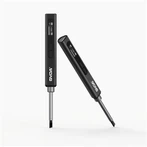The principle and accuracy of sound level meter measuring noise
Sound level meter is the most basic instrument in noise measurement, also called noise meter, decibel meter, noise measuring instrument, etc.
Sound level meters generally consist of condenser microphones, preamplifiers, attenuators, amplifiers, frequency weighting networks, and effective value indicating meters.
The working principle of the sound level meter is: the microphone converts the sound into an electrical signal, and then the preamplifier converts the impedance to match the microphone and the attenuator. The amplifier adds the output signal to the weighting network, weights the frequency of the signal (or connects an external filter), and then amplifies the signal to a certain amplitude through the attenuator and amplifier, and sends it to the effective value detector (or external voltage detector). Level recorder), giving the value of the noise level on the indicator head.
There are three standard weighting networks for frequency weighting networks in sound level meters: A, B, and C.
The A network simulates the human ear's response to the 40-square pure tone in the equal loudness curve. Its curve shape is opposite to the 340-square equal loudness curve, which causes greater attenuation in the mid- and low-frequency bands of the electrical signal. The B network simulates the human ear's response to a 70-meter pure tone, which attenuates the low-frequency band of the electrical signal to a certain extent.
The C network simulates the response of the human ear to 100 square meters of pure tone, and has an almost flat response in the entire audio frequency range. The sound pressure level measured by the sound level meter through the frequency weighting network is called sound level. Depending on the weighting network used, it is called A sound level, B sound level and C sound level respectively. The unit is recorded as dB(A) , dB(B) and dB(C).
Currently, the sound level meters used to measure noise can be divided into four types according to their sensitivity:
(1) "Slow". The time constant of the meter is 1000 ms, which is generally used to measure steady-state noise, and the measured value is the effective value.
(2) "Quick". The time constant of the meter is 125ms, which is generally used to measure unstable noise and transportation noise with large fluctuations. Fast gears are close to how the human ear responds to sound.
(3) "Pulse or pulse hold". The rising time of the needle is 35ms, which is used to measure long-duration pulse noise, such as punches, hammers, etc. The measured value is the maximum effective value.
(4) "Peak hold". The rising time of the needle is less than 20ms. It is used to measure short-duration pulse sounds, such as guns, cannons and explosions. The measured value is the peak value, which is the maximum value. Sound level meters can be connected to external filters and recorders to conduct spectrum analysis of noise.
The accuracies of sound level meters are: Level I accuracy ±0.7dB, Level II accuracy ±1dB, Level III accuracy ±1.5dB, and ordinary sound level meters are ±2dB.
Sound level meters can be divided into two categories according to their uses: one is used to measure steady-state noise, and the other is used to measure unsteady-state noise and impulse noise.
Integral sound level meters are used to measure the equivalent sound level of unstable noise over a period of time. A noise dosimeter is also an integrating sound level meter, mainly used to measure noise exposure. Pulse sound level meter is used to measure impulse noise. This sound level meter conforms to the human ear's response to impulse sound and the average time of the human ear's response to impulse sound.






